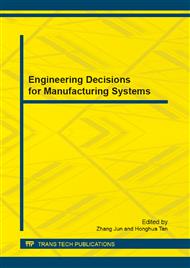p.748
p.754
p.758
p.764
p.769
p.777
p.782
p.791
p.796
Three-Phase Heuristics Algorithm for Solving JIT Materials Delivery Problem in Discrete Production System
Abstract:
To solve the just-in-time materials delivery problem in discrete production system, a three-phase heuristics algorithm is proposed to determine an appropriate materials delivery cycle-time with the constraint of delivery capacity. In which the first phase is to determine the quantity of the materials and the vehicle numbers, the second phase is to solve the travelling time of each vehicle number, and the third phase is to assign each vehicle number to specific vehicles to determine the travelling time of each vehicle. The performance of this three-phase heuristic algorithm is tested and verified by using an example experiment, and the computational results show that the average deviation just increased 0.513% compared with the well-know genetic algorithm and it is much easier to comply. It verifies the effectiveness of this heuristic algorithm in solving the just-in-time materials delivery problem in discrete production system.
Info:
Periodical:
Pages:
769-776
Citation:
Online since:
September 2013
Authors:
Price:
Сopyright:
© 2013 Trans Tech Publications Ltd. All Rights Reserved
Share:
Citation:


